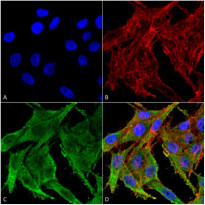ARG23724
anti-Kir4.1 antibody
anti-Kir4.1 antibody for ICC/IF,Western blot and Human,Rat
Overview
| Product Description | Rabbit Polyclonal antibody recognizes Kir4.1 |
|---|---|
| Tested Reactivity | Hu, Rat |
| Tested Application | ICC/IF, WB |
| Host | Rabbit |
| Clonality | Polyclonal |
| Isotype | IgG |
| Target Name | Kir4.1 |
| Antigen Species | Human |
| Immunogen | Synthetic peptide around the internal region of Human Kir4.1 |
| Conjugation | Un-conjugated |
| Alternate Names | KCNJ13-PEN; BIRK-10; KIR4.1; ATP-sensitive inward rectifier potassium channel 10; SESAME; Inward rectifier K; Potassium channel, inwardly rectifying subfamily J member 10; ATP-dependent inwardly rectifying potassium channel Kir4.1; KIR1.2 |
Application Instructions
| Application Suggestion |
|
||||||
|---|---|---|---|---|---|---|---|
| Application Note | * The dilutions indicate recommended starting dilutions and the optimal dilutions or concentrations should be determined by the scientist. |
Properties
| Form | Liquid |
|---|---|
| Purification | Affinity purification with immunogen. |
| Buffer | PBS, 0.09% Sodium azide and 50% Glycerol. |
| Preservative | 0.09% Sodium azide |
| Stabilizer | 50% Glycerol |
| Concentration | 1 mg/ml |
| Storage Instruction | For continuous use, store undiluted antibody at 2-8°C for up to a week. For long-term storage, aliquot and store at -20°C. Storage in frost free freezers is not recommended. Avoid repeated freeze/thaw cycles. Suggest spin the vial prior to opening. The antibody solution should be gently mixed before use. |
| Note | For laboratory research only, not for drug, diagnostic or other use. |
Bioinformation
| Database Links |
Swiss-port # P49655 Rat ATP-sensitive inward rectifier potassium channel 10 Swiss-port # P78508 Human ATP-sensitive inward rectifier potassium channel 10 |
|---|---|
| Gene Symbol | KCNJ10 |
| Gene Full Name | potassium channel, inwardly rectifying subfamily J, member 10 |
| Background | This gene encodes a member of the inward rectifier-type potassium channel family, characterized by having a greater tendency to allow potassium to flow into, rather than out of, a cell. The encoded protein may form a heterodimer with another potassium channel protein and may be responsible for the potassium buffering action of glial cells in the brain. Mutations in this gene have been associated with seizure susceptibility of common idiopathic generalized epilepsy syndromes. [provided by RefSeq, Jul 2008] |
| Function | May be responsible for potassium buffering action of glial cells in the brain. Inward rectifier potassium channels are characterized by a greater tendency to allow potassium to flow into the cell rather than out of it. Their voltage dependence is regulated by the concentration of extracellular potassium; as external potassium is raised, the voltage range of the channel opening shifts to more positive voltages. The inward rectification is mainly due to the blockage of outward current by internal magnesium. Can be blocked by extracellular barium and cesium (By similarity). [UniProt] |
| Calculated MW | 43 kDa |
Images (2) Click the Picture to Zoom In
-
ARG23724 anti-Kir4.1 antibody ICC/IF image
Immunofluorescence: Human colon carcinoma cell line (RKO) fixed by 4% Formaldehyde for 15 min at RT. Primary Antibody: ARG23724 anti-Kir4.1 antibody (green) at 1:100 for 60 min at RT. Magnification: 60X. (A) DAPI nuclear stain. (B) Phalloidin Texas Red F-Actin stain. (C) Primary antibodies. (D) Composite.
-
ARG23724 anti-Kir4.1 antibody WB image
Western blot: 15 µg of Rat liver cell lysates stained with ARG23724 anti-Kir4.1 antibody at 1:1000 for 2 hours at RT.







